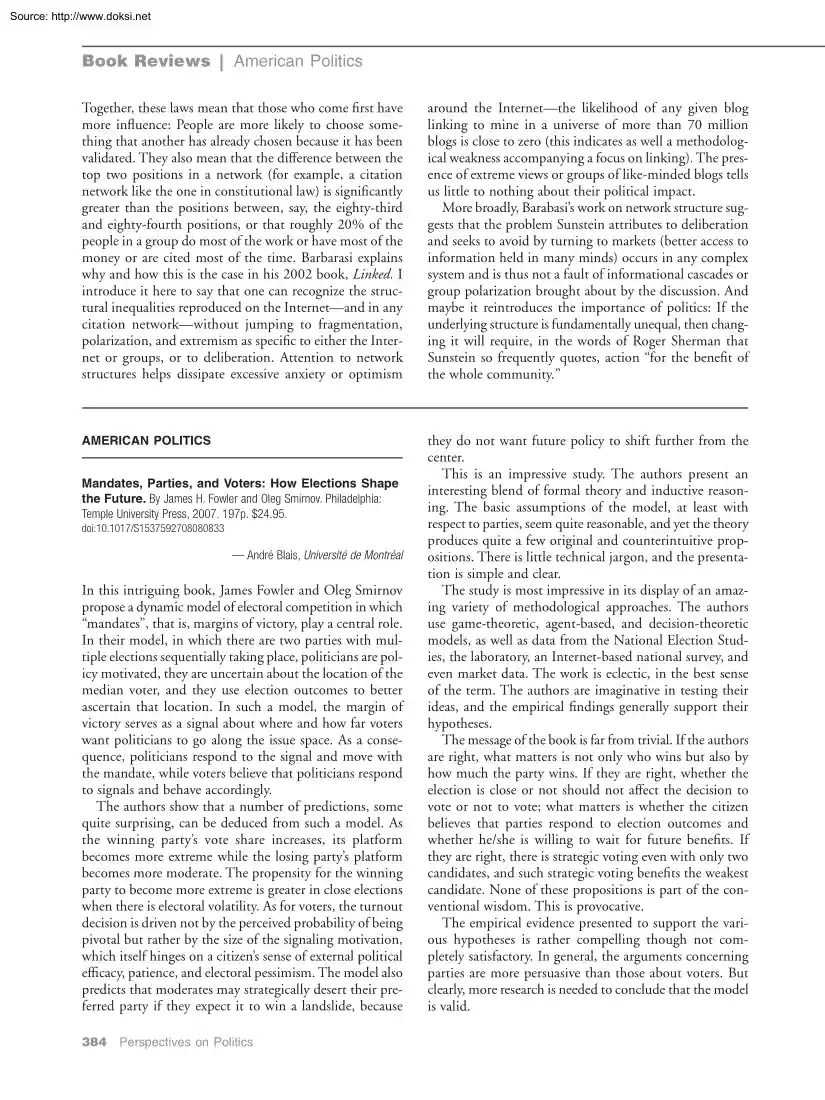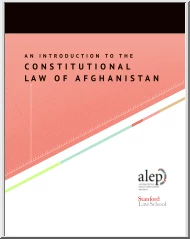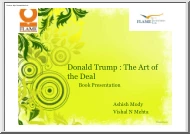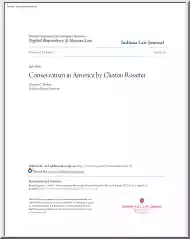A doksi online olvasásához kérlek jelentkezz be!

A doksi online olvasásához kérlek jelentkezz be!
Nincs még értékelés. Legyél Te az első!
Mit olvastak a többiek, ha ezzel végeztek?
Tartalmi kivonat
| | 䡬 Source: http://www.doksinet Book Reviews | American Politics Together, these laws mean that those who come first have more influence: People are more likely to choose something that another has already chosen because it has been validated. They also mean that the difference between the top two positions in a network (for example, a citation network like the one in constitutional law) is significantly greater than the positions between, say, the eighty-third and eighty-fourth positions, or that roughly 20% of the people in a group do most of the work or have most of the money or are cited most of the time. Barbarasi explains why and how this is the case in his 2002 book, Linked. I introduce it here to say that one can recognize the structural inequalities reproduced on the Internetand in any citation networkwithout jumping to fragmentation, polarization, and extremism as specific to either the Internet or groups, or to deliberation. Attention to network structures helps
dissipate excessive anxiety or optimism around the Internetthe likelihood of any given blog linking to mine in a universe of more than 70 million blogs is close to zero (this indicates as well a methodological weakness accompanying a focus on linking). The presence of extreme views or groups of like-minded blogs tells us little to nothing about their political impact. More broadly, Barabasi’s work on network structure suggests that the problem Sunstein attributes to deliberation and seeks to avoid by turning to markets (better access to information held in many minds) occurs in any complex system and is thus not a fault of informational cascades or group polarization brought about by the discussion. And maybe it reintroduces the importance of politics: If the underlying structure is fundamentally unequal, then changing it will require, in the words of Roger Sherman that Sunstein so frequently quotes, action “for the benefit of the whole community.” AMERICAN POLITICS they do
not want future policy to shift further from the center. This is an impressive study. The authors present an interesting blend of formal theory and inductive reasoning. The basic assumptions of the model, at least with respect to parties, seem quite reasonable, and yet the theory produces quite a few original and counterintuitive propositions. There is little technical jargon, and the presentation is simple and clear The study is most impressive in its display of an amazing variety of methodological approaches. The authors use game-theoretic, agent-based, and decision-theoretic models, as well as data from the National Election Studies, the laboratory, an Internet-based national survey, and even market data. The work is eclectic, in the best sense of the term. The authors are imaginative in testing their ideas, and the empirical findings generally support their hypotheses. The message of the book is far from trivial. If the authors are right, what matters is not only who wins but also
by how much the party wins. If they are right, whether the election is close or not should not affect the decision to vote or not to vote; what matters is whether the citizen believes that parties respond to election outcomes and whether he/she is willing to wait for future benefits. If they are right, there is strategic voting even with only two candidates, and such strategic voting benefits the weakest candidate. None of these propositions is part of the conventional wisdom This is provocative The empirical evidence presented to support the various hypotheses is rather compelling though not completely satisfactory. In general, the arguments concerning parties are more persuasive than those about voters. But clearly, more research is needed to conclude that the model is valid. Mandates, Parties, and Voters: How Elections Shape the Future. By James H Fowler and Oleg Smirnov Philadelphia: Temple University Press, 2007. 197p $2495 doi:10.1017/S1537592708080833 䡬 André Blais,
Université de Montréal In this intriguing book, James Fowler and Oleg Smirnov propose a dynamic model of electoral competition in which “mandates”, that is, margins of victory, play a central role. In their model, in which there are two parties with multiple elections sequentially taking place, politicians are policy motivated, they are uncertain about the location of the median voter, and they use election outcomes to better ascertain that location. In such a model, the margin of victory serves as a signal about where and how far voters want politicians to go along the issue space. As a consequence, politicians respond to the signal and move with the mandate, while voters believe that politicians respond to signals and behave accordingly. The authors show that a number of predictions, some quite surprising, can be deduced from such a model. As the winning party’s vote share increases, its platform becomes more extreme while the losing party’s platform becomes more moderate.
The propensity for the winning party to become more extreme is greater in close elections when there is electoral volatility. As for voters, the turnout decision is driven not by the perceived probability of being pivotal but rather by the size of the signaling motivation, which itself hinges on a citizen’s sense of external political efficacy, patience, and electoral pessimism. The model also predicts that moderates may strategically desert their preferred party if they expect it to win a landslide, because 384 Perspectives on Politics 䡬 | | 䡬 Source: http://www.doksinet I found the model and the empirical findings directly related to the mandate model particularly interesting and valuable, but the authors seem to assume that all politicians have extremist ideal points. Even though it is probably the case that politicians tend to be less centrist than voters, one should allow for a variety of ideal points, and as a consequence the propensity for the winning party or
candidate to become more extremist should be conditional on the location of the ideal point. On the empirical side, the data on candidate ideology in U.S Senate elections neatly confirm their hypotheses, but the authors do not explain why, in Chapter 3, they relate changes in ideology to previous vote share rather than to changes in previous vote share. I have more questions when it comes to their analysis of voter behavior. A voter’s main motivation in the model is to signal a policy position. This may seem to solve the paradox of voting since citizens do not need to consider whether they could be pivotal in helping their party win the election. The concern now is to help their party win as many votes as possible. The point remains, however, that the impact of any single vote on the margin of victory is bound to be minimal, and so the rational decision is still to abstain. The authors recognize the problem, and they write that the signaling motivation cannot be the only incentive to
vote and that in their mind, voters are not necessarily fully informed or rational (pp. 74–75) But clearly this is not a very satisfactory solution. On the empirical side, the finding that I find most puzzling is the one according to which one of the most important determinants of turnout is patience. The more impatient one is, the greater likelihood to abstain. As far as I can tell, this factor had never been mentioned in the huge literature on turnout. Again the authors are imaginative and original, and this make sense given their theoretical model In their view, voters care about mandates and future elections, and those who have a longer time perspective, that is, those who are “patient,” will be more induced to vote. Fowler and Smirnov show through two different studies, based on two different data sets and different indicators, a relatively strong correlation between patience and turnout. I remain skeptical. I assume that those who are willing to wait longer for a larger
prize in a game (the indicator of patience in one study) may have other personality characteristics that also induce them to vote. I would also argue that in their model, patience should have only a conditional effect on the decision to vote, that the impact should be observed only among those who believe that the parties do respond to mandates. This conditional (or interactive) effect is not specifically tested in their empirical analyses. In short, this is a thoughtful and provocative book. The authors propose a new way of looking at both parties and voters, and they present a wide array of empirical findings that are consistent with their model. They have not quite succeeded in convincing me, however, that I should relinquish my view that most voters are cynical and myopic. But it is refreshing to be challenged by such a neat model and such neat results. Local Democracy Under Siege: Activism, Public Interests, and Private Politics. By Dorothy Holland, Donald M. Nonini, Catherine
Lutz, Lesley Bartlett, Marla Frederick-McGlathery, Thaddeus C. Guldbradsen, and Enrique G. Murillo, Jr New York: New York University Press, 2007 302p. $7500 cloth, $22 paper doi:10.1017/S1537592708080845 Daniel A. Smith, University of Florida This is an ambitious yet ultimately frustrating book. Written by seven anthropologists who undertook several years of intermittent ethnographic fieldwork in North Carolina in the late 1990s, the collaborative effort explores the currents of American democracy in five (two urban and three smaller) communities in an effort to gauge the state of democratic participation in America. By means of thumbnail portraits of ordinary people and grassroots organizations, the study at its best offers new theoretical insights into the political engagement and efficacy of individuals confronting the forces of globalization, market rule, and forces of privatization. The authors provide numerous examples of individuals in the five communities who are estranged
from democratic institutions, documenting myriad structural barriers to participation for many residents. With dollops of guarded optimism, though, they also highlight the alternative modes of empowerment and political participation that individuals are able to achieve through various forms of voluntary grassroots associations. At the other extreme, the book elides a considerable amount of scholarly literature on democratic theory, political participation, local governance, and political power. It also suffers from being thematically disjointed, and at times reads not as a scholarly treatise but as a thinly disguised polemic against American plutocracy and government-by-outsourcing. Unquestionably, the book offers a rich tapestry of the quotidian political life in North Carolina. Living in the five communities for varying lengths of times in the late 1990s, the authors observed meetings, conversed formally and informally with residents of all social strata, read local newspapers and
listened to local radio stations, attended church and public meetings, endured youth soccer games, and visited informants in their homes. Empirically, the book is grounded by 93 in-depth interviews of people living in the five communities, along with portrayals of five local organizations. Political scientists, especially behavioralists keen on hypothesis testing, have much to gain from the numerous anecdotal insights into the political attitudes toward the public good and the various forms of political behavior in which ordinary people regularly June 2008 | Vol. 6/No 2 385 䡬 䡬
dissipate excessive anxiety or optimism around the Internetthe likelihood of any given blog linking to mine in a universe of more than 70 million blogs is close to zero (this indicates as well a methodological weakness accompanying a focus on linking). The presence of extreme views or groups of like-minded blogs tells us little to nothing about their political impact. More broadly, Barabasi’s work on network structure suggests that the problem Sunstein attributes to deliberation and seeks to avoid by turning to markets (better access to information held in many minds) occurs in any complex system and is thus not a fault of informational cascades or group polarization brought about by the discussion. And maybe it reintroduces the importance of politics: If the underlying structure is fundamentally unequal, then changing it will require, in the words of Roger Sherman that Sunstein so frequently quotes, action “for the benefit of the whole community.” AMERICAN POLITICS they do
not want future policy to shift further from the center. This is an impressive study. The authors present an interesting blend of formal theory and inductive reasoning. The basic assumptions of the model, at least with respect to parties, seem quite reasonable, and yet the theory produces quite a few original and counterintuitive propositions. There is little technical jargon, and the presentation is simple and clear The study is most impressive in its display of an amazing variety of methodological approaches. The authors use game-theoretic, agent-based, and decision-theoretic models, as well as data from the National Election Studies, the laboratory, an Internet-based national survey, and even market data. The work is eclectic, in the best sense of the term. The authors are imaginative in testing their ideas, and the empirical findings generally support their hypotheses. The message of the book is far from trivial. If the authors are right, what matters is not only who wins but also
by how much the party wins. If they are right, whether the election is close or not should not affect the decision to vote or not to vote; what matters is whether the citizen believes that parties respond to election outcomes and whether he/she is willing to wait for future benefits. If they are right, there is strategic voting even with only two candidates, and such strategic voting benefits the weakest candidate. None of these propositions is part of the conventional wisdom This is provocative The empirical evidence presented to support the various hypotheses is rather compelling though not completely satisfactory. In general, the arguments concerning parties are more persuasive than those about voters. But clearly, more research is needed to conclude that the model is valid. Mandates, Parties, and Voters: How Elections Shape the Future. By James H Fowler and Oleg Smirnov Philadelphia: Temple University Press, 2007. 197p $2495 doi:10.1017/S1537592708080833 䡬 André Blais,
Université de Montréal In this intriguing book, James Fowler and Oleg Smirnov propose a dynamic model of electoral competition in which “mandates”, that is, margins of victory, play a central role. In their model, in which there are two parties with multiple elections sequentially taking place, politicians are policy motivated, they are uncertain about the location of the median voter, and they use election outcomes to better ascertain that location. In such a model, the margin of victory serves as a signal about where and how far voters want politicians to go along the issue space. As a consequence, politicians respond to the signal and move with the mandate, while voters believe that politicians respond to signals and behave accordingly. The authors show that a number of predictions, some quite surprising, can be deduced from such a model. As the winning party’s vote share increases, its platform becomes more extreme while the losing party’s platform becomes more moderate.
The propensity for the winning party to become more extreme is greater in close elections when there is electoral volatility. As for voters, the turnout decision is driven not by the perceived probability of being pivotal but rather by the size of the signaling motivation, which itself hinges on a citizen’s sense of external political efficacy, patience, and electoral pessimism. The model also predicts that moderates may strategically desert their preferred party if they expect it to win a landslide, because 384 Perspectives on Politics 䡬 | | 䡬 Source: http://www.doksinet I found the model and the empirical findings directly related to the mandate model particularly interesting and valuable, but the authors seem to assume that all politicians have extremist ideal points. Even though it is probably the case that politicians tend to be less centrist than voters, one should allow for a variety of ideal points, and as a consequence the propensity for the winning party or
candidate to become more extremist should be conditional on the location of the ideal point. On the empirical side, the data on candidate ideology in U.S Senate elections neatly confirm their hypotheses, but the authors do not explain why, in Chapter 3, they relate changes in ideology to previous vote share rather than to changes in previous vote share. I have more questions when it comes to their analysis of voter behavior. A voter’s main motivation in the model is to signal a policy position. This may seem to solve the paradox of voting since citizens do not need to consider whether they could be pivotal in helping their party win the election. The concern now is to help their party win as many votes as possible. The point remains, however, that the impact of any single vote on the margin of victory is bound to be minimal, and so the rational decision is still to abstain. The authors recognize the problem, and they write that the signaling motivation cannot be the only incentive to
vote and that in their mind, voters are not necessarily fully informed or rational (pp. 74–75) But clearly this is not a very satisfactory solution. On the empirical side, the finding that I find most puzzling is the one according to which one of the most important determinants of turnout is patience. The more impatient one is, the greater likelihood to abstain. As far as I can tell, this factor had never been mentioned in the huge literature on turnout. Again the authors are imaginative and original, and this make sense given their theoretical model In their view, voters care about mandates and future elections, and those who have a longer time perspective, that is, those who are “patient,” will be more induced to vote. Fowler and Smirnov show through two different studies, based on two different data sets and different indicators, a relatively strong correlation between patience and turnout. I remain skeptical. I assume that those who are willing to wait longer for a larger
prize in a game (the indicator of patience in one study) may have other personality characteristics that also induce them to vote. I would also argue that in their model, patience should have only a conditional effect on the decision to vote, that the impact should be observed only among those who believe that the parties do respond to mandates. This conditional (or interactive) effect is not specifically tested in their empirical analyses. In short, this is a thoughtful and provocative book. The authors propose a new way of looking at both parties and voters, and they present a wide array of empirical findings that are consistent with their model. They have not quite succeeded in convincing me, however, that I should relinquish my view that most voters are cynical and myopic. But it is refreshing to be challenged by such a neat model and such neat results. Local Democracy Under Siege: Activism, Public Interests, and Private Politics. By Dorothy Holland, Donald M. Nonini, Catherine
Lutz, Lesley Bartlett, Marla Frederick-McGlathery, Thaddeus C. Guldbradsen, and Enrique G. Murillo, Jr New York: New York University Press, 2007 302p. $7500 cloth, $22 paper doi:10.1017/S1537592708080845 Daniel A. Smith, University of Florida This is an ambitious yet ultimately frustrating book. Written by seven anthropologists who undertook several years of intermittent ethnographic fieldwork in North Carolina in the late 1990s, the collaborative effort explores the currents of American democracy in five (two urban and three smaller) communities in an effort to gauge the state of democratic participation in America. By means of thumbnail portraits of ordinary people and grassroots organizations, the study at its best offers new theoretical insights into the political engagement and efficacy of individuals confronting the forces of globalization, market rule, and forces of privatization. The authors provide numerous examples of individuals in the five communities who are estranged
from democratic institutions, documenting myriad structural barriers to participation for many residents. With dollops of guarded optimism, though, they also highlight the alternative modes of empowerment and political participation that individuals are able to achieve through various forms of voluntary grassroots associations. At the other extreme, the book elides a considerable amount of scholarly literature on democratic theory, political participation, local governance, and political power. It also suffers from being thematically disjointed, and at times reads not as a scholarly treatise but as a thinly disguised polemic against American plutocracy and government-by-outsourcing. Unquestionably, the book offers a rich tapestry of the quotidian political life in North Carolina. Living in the five communities for varying lengths of times in the late 1990s, the authors observed meetings, conversed formally and informally with residents of all social strata, read local newspapers and
listened to local radio stations, attended church and public meetings, endured youth soccer games, and visited informants in their homes. Empirically, the book is grounded by 93 in-depth interviews of people living in the five communities, along with portrayals of five local organizations. Political scientists, especially behavioralists keen on hypothesis testing, have much to gain from the numerous anecdotal insights into the political attitudes toward the public good and the various forms of political behavior in which ordinary people regularly June 2008 | Vol. 6/No 2 385 䡬 䡬




 Évről-évre egyre jelentősebbé válik az internetes álláspiac, hiszen számos offline hirdetési forma szűnt meg az álláskereső portálok térnyerésével. A gördülékeny egymásra találásnak köszönhetően a munkahelyváltás könnyebb, mint valaha. Tudd meg, hogyan!
Évről-évre egyre jelentősebbé válik az internetes álláspiac, hiszen számos offline hirdetési forma szűnt meg az álláskereső portálok térnyerésével. A gördülékeny egymásra találásnak köszönhetően a munkahelyváltás könnyebb, mint valaha. Tudd meg, hogyan!